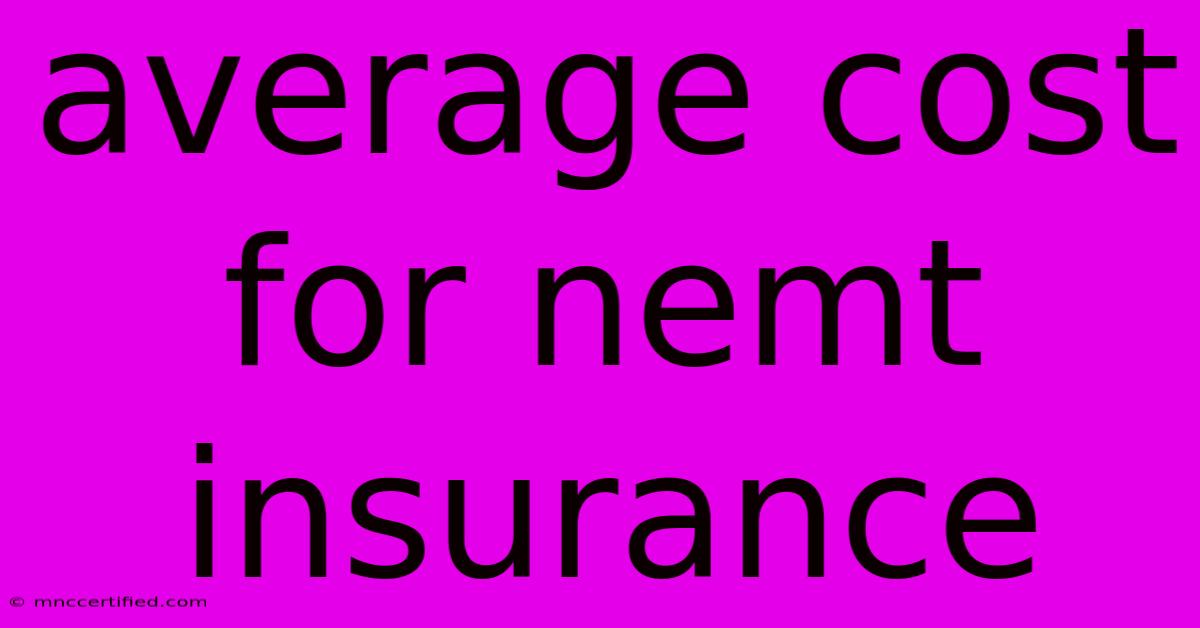Average Cost For Nemt Insurance

Table of Contents
Decoding the Average Cost of NEMT Insurance: A Comprehensive Guide
Navigating the world of Non-Emergency Medical Transportation (NEMT) insurance can feel overwhelming. Understanding the average cost is crucial for businesses operating in this sector, ensuring compliance and maintaining financial stability. This comprehensive guide breaks down the factors influencing NEMT insurance premiums, providing you with a clearer picture of what to expect.
What Influences the Average Cost of NEMT Insurance?
The cost of NEMT insurance isn't a one-size-fits-all figure. Several factors significantly impact the premium you'll pay. These include:
1. Type of Coverage:
- Liability Insurance: This covers claims against your company for bodily injury or property damage caused by your vehicles or employees. This is generally mandatory and the foundation of your NEMT insurance.
- Commercial Auto Insurance: This extends liability coverage and often includes collision and comprehensive coverage to protect your vehicles.
- Umbrella Insurance: Provides additional liability protection beyond your basic policy limits, offering crucial financial security in case of significant claims.
- Workers' Compensation Insurance: This is vital if you employ drivers and other staff. It covers medical expenses and lost wages for employees injured on the job.
The more comprehensive your coverage, the higher your premium. Choosing the right level of coverage depends on your risk tolerance and the size of your operation.
2. Vehicle Type and Number:
The type and number of vehicles in your fleet directly impact your premium. Larger vehicles, such as wheelchair vans, generally command higher premiums due to increased risk and repair costs. The more vehicles you insure, the higher the overall cost, though you may be able to negotiate better rates with insurers due to volume.
3. Geographic Location:
Insurance rates vary significantly based on location. Areas with higher accident rates or more frequent claims will typically have higher premiums. Urban areas, for instance, often have higher rates than rural areas.
4. Driver Experience and Safety Record:
Insurers consider the experience and safety records of your drivers. A fleet with experienced, well-trained drivers with clean driving records will generally qualify for lower premiums than a fleet with less experienced or high-risk drivers. Investing in driver training is a smart way to reduce your insurance costs in the long run.
5. Claims History:
Your company's claims history is a major factor. A history of frequent or significant claims will inevitably result in higher premiums. Implementing robust safety protocols and driver training programs can help minimize claims and keep premiums lower.
6. Insurer and Policy Options:
Different insurers offer various coverage options and pricing structures. Shopping around and comparing quotes from multiple insurers is crucial to finding the best rate. Be sure to compare not just the price but also the coverage offered.
Estimating the Average Cost:
While pinning down a precise average cost is impossible due to the variability of the factors mentioned above, expect to pay anywhere from a few hundred dollars to several thousand dollars per vehicle per year. Smaller operations with fewer vehicles and minimal claims history may fall on the lower end of this spectrum, while larger fleets with extensive coverage and a higher-risk profile may fall on the higher end.
Tips for Reducing NEMT Insurance Costs:
- Implement a robust driver safety program: This includes regular training, background checks, and driving record monitoring.
- Maintain well-maintained vehicles: Regular maintenance reduces the risk of accidents and breakdowns.
- Invest in telematics: Telematics devices can monitor driver behavior and identify areas for improvement.
- Shop around and compare quotes: Obtain quotes from multiple insurers to find the best rates and coverage.
- Negotiate with your insurer: Don't hesitate to negotiate your premiums, especially if you have a strong safety record and a clean claims history.
Conclusion:
The average cost of NEMT insurance is highly variable. Understanding the factors that influence premiums empowers you to make informed decisions, secure appropriate coverage, and manage your operational costs effectively. By proactively managing risk, maintaining a strong safety record, and diligently comparing quotes, you can significantly reduce your NEMT insurance expenses and ensure your business thrives. Remember to consult with an insurance professional to determine the best coverage for your specific needs and circumstances.

Thank you for visiting our website wich cover about Average Cost For Nemt Insurance. We hope the information provided has been useful to you. Feel free to contact us if you have any questions or need further assistance. See you next time and dont miss to bookmark.
Featured Posts
-
Toulouse Falls To Psg Winning Run Continues
Nov 23, 2024
-
Las Vegas Gp Qualifying Start Time And Tv Channel
Nov 23, 2024
-
Chers Scathing Director Reviews
Nov 23, 2024
-
Argyles World Cup Stadium Plans Unveiled
Nov 23, 2024
-
Personal Line Insurance License
Nov 23, 2024